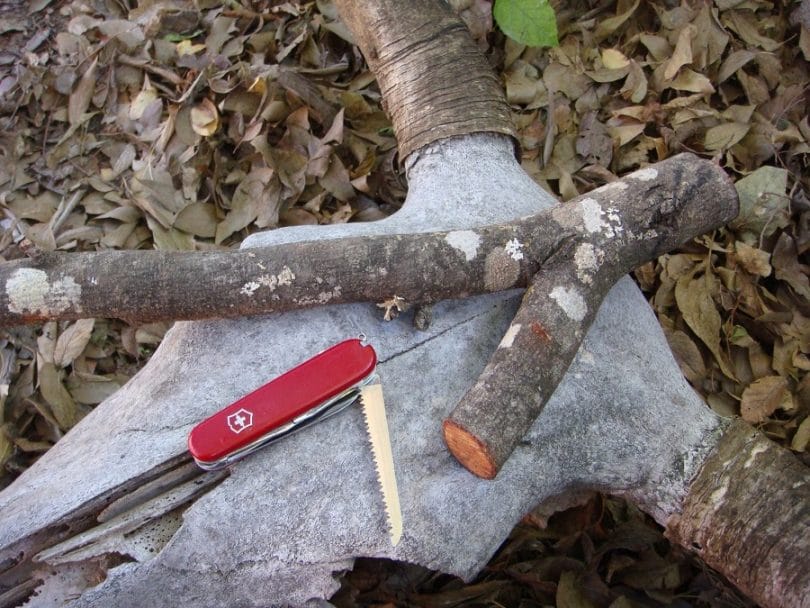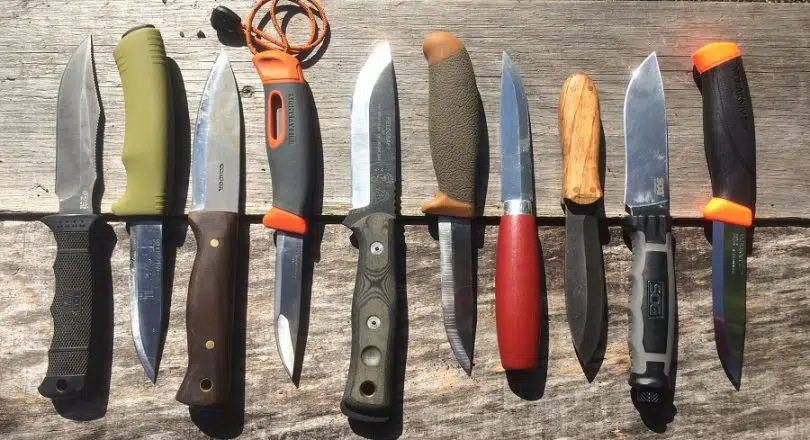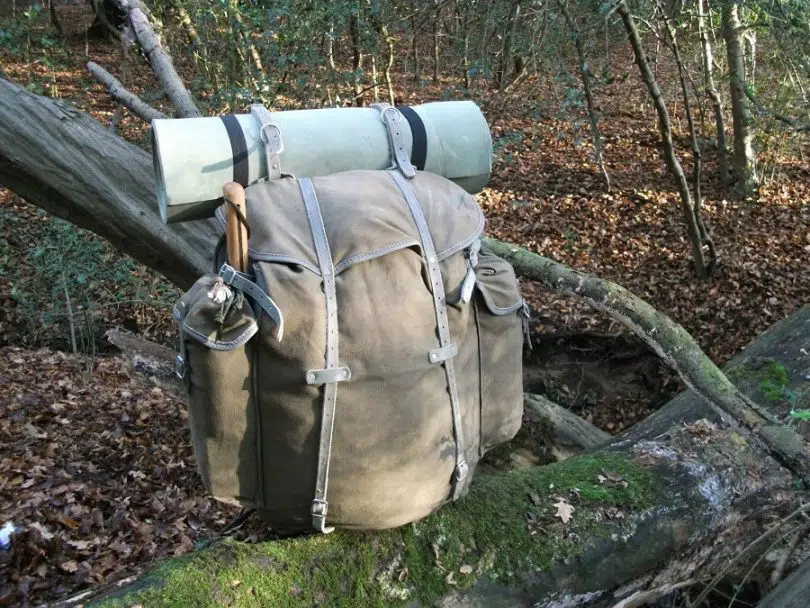Living off the land requires bushcraft tools and can be beneficial should the need arise where you don’t have a choice. This is not the same as prepping, where people store canned goods and fuel to survive worst-case scenarios.
Using bushcraft tools will help you survive and thrive regardless of the situation, using what nature has provided. Knowing essential bushcraft tools you should have on hand will make it easier to find the food and water you need. This is a more primitive style of camping.
Buying or Making
For those who don’t know how to make these themselves, buying these tools beforehand can make all the difference in the world. It may cost you more, but good tools will last a long time.
However, you should learn how to build your tools from scratch in case your purchased tools break or you’re suddenly trapped without them. Understanding how to build tools will also help you evaluate other tools, and what will and will not work.

Studying stonework, whittling, and knapping will be handy when building your tools out of natural materials.
The essential bushcraft tools that you’re going to need are divided into five basic categories:
- Fixed blade knives
- Axes
- Saws
- Hatchets
- Machetes
Fixed Blade Knives
Your fixed blade knife should be well made and able to provide years of use without rusting or breaking. This knife is most suitable for light to medium work, involving whittling, preparing food, skinning the game you catch, making snares, and cutting small branches.
In a pinch, this knife can also be used to defend yourself. A good knife will be essential and is not something you want cut corners on, so make sure you purchase or make a quality fixed blade knife.

It’s essential you take care of your knife and keep it clean, so it won’t get dull or start to rust. To clean your knife create a mild soap and water solution, and use a clean rag to remove any dirt or debris from its surface that may have accumulated.
It’s also important that the blade remains dry. After you’ve cleaned your knife, use WD-40 to remove any water spots which will prevent oxidation from occurring. Oil all the metal parts regularly to keep them in good condition.
The most important thing is to keep your knife sharp. A sharp knife is easier to use and will save you time and energy when you need it most. If you don’t know how to sharpen it yourself, you can always purchase a knife sharpening kit and practice on cheap knives rather than your expensive ones.
When not in use, you will have to keep your knife somewhere. This is done not only to keep it dry but also to keep you safe. A stray knife can easily puncture the body, and if you’re injured in the wild bleeding, it may be some time before help arrives.
The blade should be oiled before being stored in a cardboard sheath in a cool dry place with low humidity. Using nylon or leather will lead to moisture being trapped, and this will cause the knife to rust.
Hatchets and Axes
These tools are designed for cutting wood to build shelters or start a fire. However, they’re also suitable for heavier tasks, such as downing trees, chopping wood, splitting logs, digging, hammering in posts, and butchering large game you catch.
Axes and hatchets can range from small hand tools to very large, but remember than in many wilderness situations, especially if you are moving fast, you want to keep your load light.

To keep your hatchet or ax clean, you need to keep the head completely dry. Use a dry cloth to remove any excess water, and add some turpentine to the rag to remove any dirt and wood sap that may have gotten stuck to it.
If you find rust, then you should use fine sandpaper or steel wool to remove it. Keeping them rust-free will help them last longer, and there are several methods you can use to accomplish this:
- Spray the blades with light lubricant or oil after using them
- Use gun oil as a cleaner and rust protector
- Motor oil protects and lubricates the ax head
- Car or floor wax will inhibit rusting and create a waterproof barrier
- Beeswax or linseed oil
Your ax or hatchet should be sharpened regularly so that it’s always ready to use when needed. After cleaning and honing, you must store your ax or hatchet effectively.
After applying a rust inhibitor, you should remove the excess and cover the head with a cloth or sheathe. They should then be placed in a cool and dry place.
Deciding on the best survival ax requires going through a lot of choices, so I’ve written an article that provides some tips and reviews.
Machetes
A machete is a hybrid combination of a large knife and an ax or hatchet. Its long blade is a good cutting tool but not strong enough to fall large trees. Instead, it can be used to slash vines and tall grasses to clear a path and defend yourself against much larger predators.

Machetes should also be kept clean and well oiled, and they should never be soaked in water to clean them. Instead, use a soap and water solution, and a clean rag to remove any dirt or debris.
Once they’ve been cleaned, they need to be thoroughly dried. WD-40 can be applied to remove any moisture, and a light oil coating should be added to prevent rust or corrosion. This should be done regularly to maintain the functionality of the machete.
You should use sharpening stones or metal tools to keep your machete sharp. Practice using these before heading out into the wilderness so you know what you’re doing.
When it comes to storing your machete, you should oil it and store it in a cardboard sheath to keep out moisture. A machete should also be stored in a cool,dry place.
We have written an article with tips on choosing the best survival machete, along with reviews of some popular machetes currently on the market.
Saws
Saws serve the same purpose as hatchets and axes when cutting wood, but provide a much cleaner cut. Saws are used when building something from wood, whether a structure, chairs, tables, firewood, or another tool.

Saws should be cleaned after each use, as any build-up, sap, or debris within the teeth will dull them and make them much more challenging to use. Alcohol can be used to remove sticky residue, but kerosene can also be used if that doesn’t work.
A saw should be washed and cleaned after use, and any spots of rust should be removed with sandpaper or steel wool. Check your saw to ensure that none of the teeth are missing or cracked. If the blade itself is damaged, then it should be replaced. Using a damaged tool can result in it breaking while in use, which may result in injury.
When storing your saw, it should be cleaned and oiled to protect the blade from moisture. In addition, it should be kept in a cool, dry area.
Backpacks
Outside of the tools, you’ll need to survive; you’ll need something to carry them all. Finding the right backpack is important, as you’ll need something durable and waterproof so your belongings won’t get soaked. Backpacks can also be used to store things that you may pick up along the way, including crafting materials and food.

If you don’t have a backpack with you, one can be made from animal skins or by weaving together plant stems and leaves. Knowing some crafting skills such as weaving or leatherwork can help you create a functional backpack. Trying to carry everything can slow you down and waste energy that you need for more critical tasks.
Just like your other tools, backpacks will also need to be maintained. Holes are a natural result of use, and you need to know how to repair them. If taken care of properly, a good backpack can last as long as ten years, if not longer. When investing in a backpack, you should look for the following features:
- Weather Resistant
- A durable, comfortable frame
- Multiple compartments to organize gear
- Large enough to carry the gear and food you need
Check out this article on how to choose a good survival backpack, along with product reviews.
Non-blade Tools
Although the five sets of basic bushcraft tools are essential, there are some other tools that you can bring with you that will make your life a little easier.
Bush crafting focuses on roughing it, but these small conveniences can help keep spirit and morale up in tough situations.

These tools are small, light and they won’t overburden you with unnecessary weight. Here’s a list of some things to consider bringing with you.
- Whetstone: Since most of your bushcraft tools are bladed, you’ll need to sharpen them. A whetstone is your best bet, and it’s important to have one. You can try and make one but it is often easier to purchase one since they are not expensive.
- Firestarter: Fires are the best way to cook food and provide warmth when the weather gets colder. The heat can also help to boost morale and keep the mood upbeat.
Fire is also essential for sterilizing your tools and cauterizing wounds when there are injuries. Knowing how to start a fire on your own is essential, but if you don’t, a fire starter can be used thousands of times to get a good fire going. - Water purifier: boiling the water you find can be the best way to ensure it’s safe to drink. But cooking it can use a lot of your firewood and take a long time. If you’re on the run or unable to make a fire for some reason, having a water purifier on hand can make things easier for you. Water purification tablets can kill the most harmful bacteria and viruses you can find in water and make it safer to drink. You can also fit many of them into a small pack, making them easy to carry.
- Means of navigation: getting lost is easy when all the trees look the same. You don’t want to be trapped in the wilderness without any way of getting back to civilization. Having a map on hand and a compass can help you be aware of where you are and how to get from point A to B.
- Cookware: having a fire is well and good, but it can be beneficial to have something to eat your meals with. Adding some meat and vegetables to a lightweight aluminum pot can make the best soup, which can feel and keep you warm for an extended period. A few utensils and plates, just enough to make yourself comfortable, can’t hurt either.
- Clothing: your clothes will inevitably get dirty and smelly. Having a change of clothes will help you feel better than wearing the same outfit every day, and you won’t always have the time to wash them to make them clean. You should always carry a few changes of underwear and socks to prevent infections, as athlete’s foot can be quite irritating. You want clothing that’s going to be waterproof as well as breathable.
- Shelter: You won’t be sleeping under the stars every night. There will be bad weather and cold. You might be able to build your shelter out of natural materials, but having a backup shelter can always make things a little easier. If not a tent, then a good quality tarp can be enough to keep you dry from the elements.
A sleeping bag or even a waterproof blanket can keep you comfortable when sleeping on the ground. Always think in layers, so you’re prepared for whatever weather comes your way, and invest in a hat to keep the sun out of your eyes. - First aid kits: Wounds, insect bites, and allergic reactions will happen whether you want them to or not. You could be the best planner in the world, and accidents will still occur. Having a first aid kit to take care of these will prevent infections from setting in and will also lighten the suffering that you may experience.
The first aid kit you bring should be compact, light weight, and include adhesive, gauze, bandages, alcohol wipes, scissors, tweezers, finger splints, various ointments for burns, and insect bites, cold packs, hand sanitizer, aspirin, Benadryl, and anti-diarrhea pills. This is just a small list of essential things to consider. - Snare wire: Snare wire can make it easier to catch prey you plan on eating and doesn’t take up a lot of space or weight in your pack.
- Fishing lines and hooks: A branch and some line is all you need, as you can find grubs and worms out in nature to serve as bait. It can be a change of pace in your meals, especially if you’re having difficulty catching other game.
- Bug-out bags: It’s essential to have a bug-out bag in case of an emergency. This is a bag of the bare essentials you’ll need for 72 hours when a disaster occurs, such as an earthquake or a fire.
Your bug-out bag should include your bushcraft tools, as well as the bare essentials such as water, some dried food, basic first aid necessities, some spare clothing, a fire starter, a light source and batteries, your compass, and some means of communication .
Necessary Skills
The tools you’ll bring with you are only as valuable as the knowledge and skill you have to use them. A knife doesn’t do you any good if you don’t know how to trap prey or skin them it the first place.
Having a good set of skills to survive in the wild includes learning how to hunt and trap, forage for other sources of food, purify water, build a shelter, and build a fire. Without these skills, you’re as good as dead, even with bushcraft tools at your disposal.

Learning bushcraft requires a lot of preparation, time, patience, and the right mindset for living in the wilderness with nothing but the tools you can carry. You will need an open mind, positive attitude, and persistance.






People interested in learning bushcraft skills can check out YouTube channels like Wilderness outfitters and Cedrik Grenier’s channel. Good books to read are Bushcraft by Mors Kochanski, Essential Bushcraft by Ray Mears, and Dave Canterbury’s Bushcraft 101 book. You need to practice what you read though. So as a beginner just get a solid knife but don’t overspend. Practice knife sharpening, how to carve out eating utensils, or make feather-sticks. Get a good solid axe too like the Wetterlings axe and practice how to use it safely and effectively.
That’s a good approach as far as learning bushcrafting skills is concerned. Apart from a good bushcraft knife, there are other tools that you will need to live in the wild, such as machetes, axe, saws, and so on. Read more to learn the importance of these tools.
For your first aid kit I would suggest adding Steri-Strips to help speed healing and reduce the chances of infection; a benzoin compound tincture to prevent infection on major cuts and abrasions; gauze pads to prevent dirt entering the wound; and some wound sealing/clotting powder if you are taking some blood thinners.
While there are some good outdoor first aid kits on the market, there is great value in putting together your own bushcraft first aid kit. This way, you get to assemble the most essential items.
I have always carried a couple of paperback books. Seems odd to many but they have saved me a time or two.Paper for fire and toilet paper if in a bind. If you are alone on the trail, sitting down and reading will calm your nerves and relax you when needed. It beats talking to your horse all the time if riding the trails. However, I still talk to my horse all the time. He can be a good friend and ear when you need it and sometimes knows the way better than you will..
It’s always good to do with whatever is at hand, and the paperback books seems to be working just fine for you. A good outdoorsman is one that can improvise.
This is a great list Samuel, if I were starting over, and building my gear from scratch. I think I’d probably skip the axe in the early days in favor of a folding saw. As for the inexperienced bushcrafter, the latter is much easier to use. I’d also add tarp to the list, particularly for those who are opting to construct their own shelter. That way, if your construction doesn’t go quite to plan (which is often the case in the early days), you’ll have something that can be used to knock up a quick shelter to keep you out of the rain.
The best bushcrafting tool is one that you can effectively use when need be. Therefore, you always have to pack tools that are absolutely necessary for your situation.